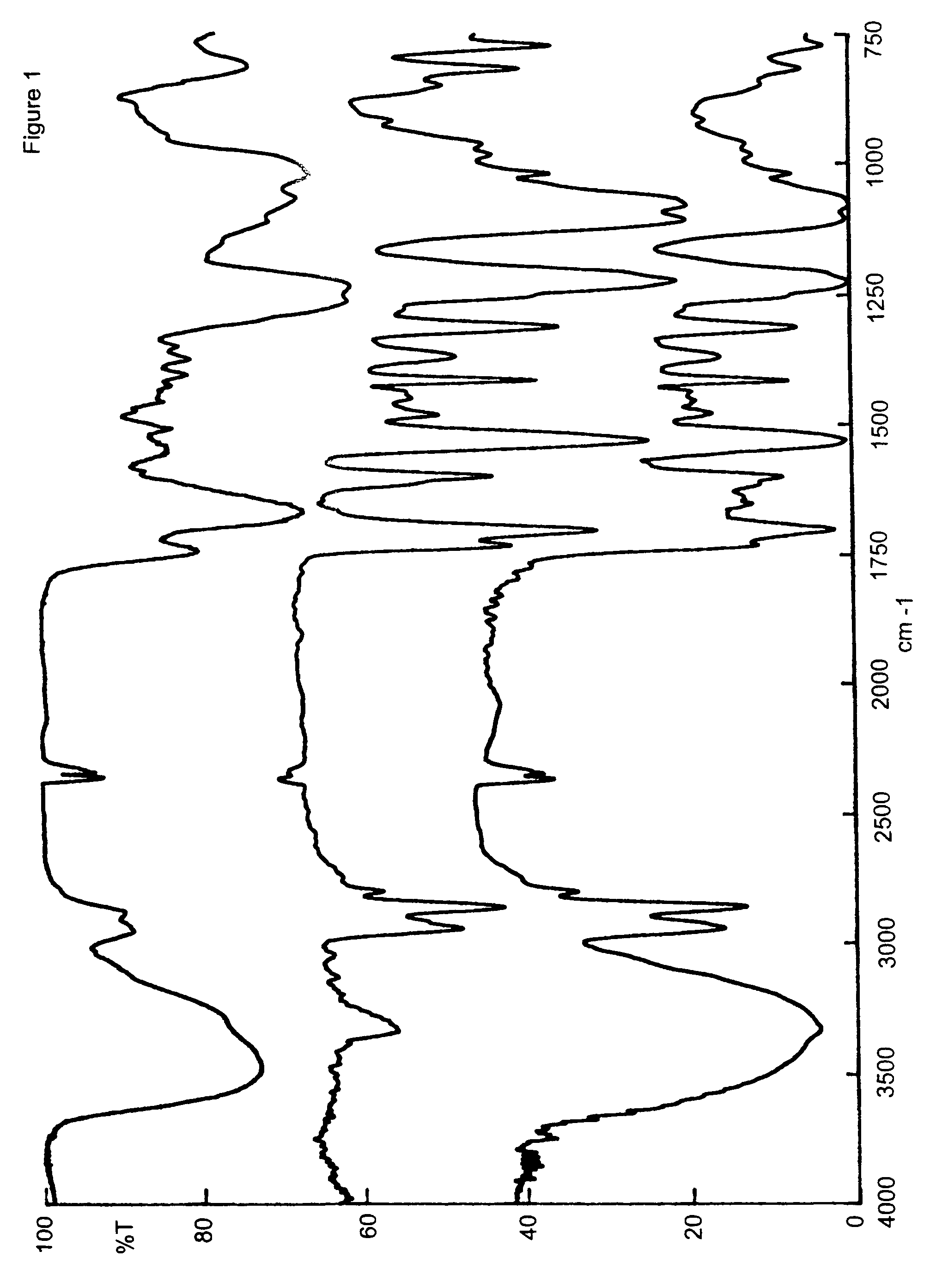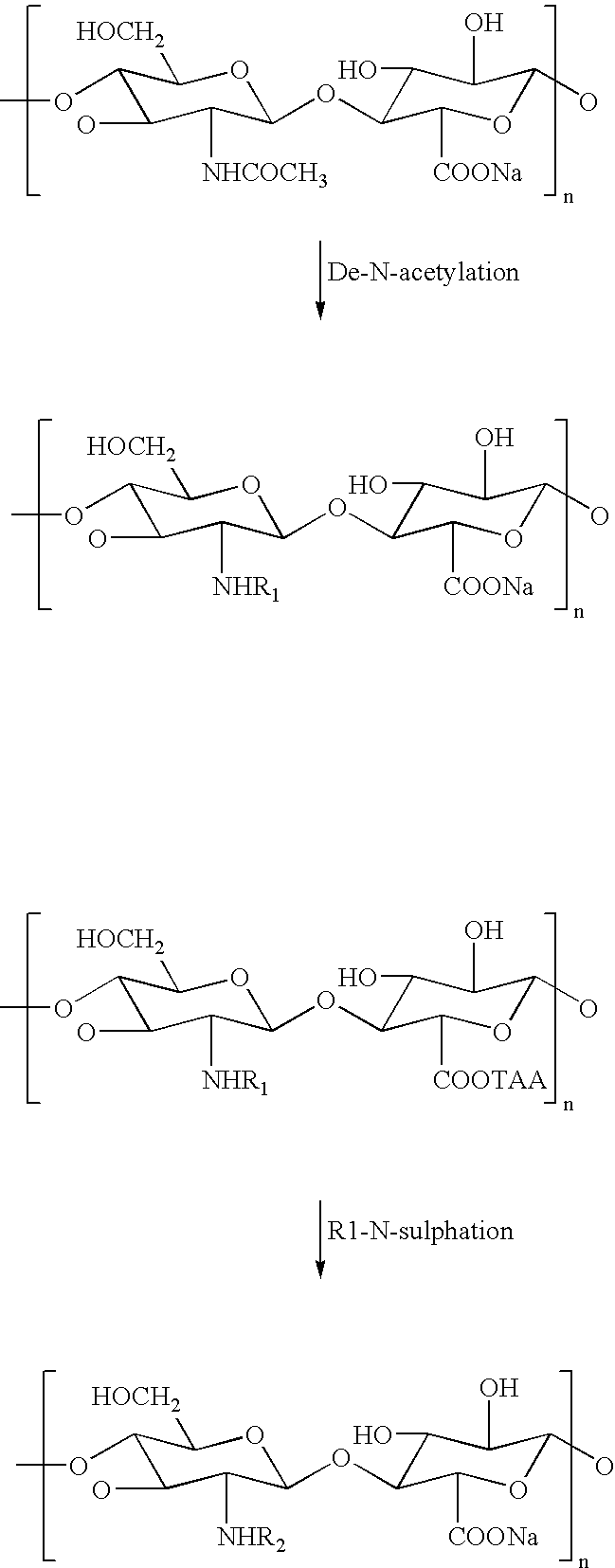Sulphated hyaluronic acid and sulphated derivatives thereof covalently bound to polyurethanes, and the process for their preparation
- Summary
- Abstract
- Description
- Claims
- Application Information
AI Technical Summary
Benefits of technology
Problems solved by technology
Method used
Image
Examples
example 1
Polyurethane Covalently Bound to O-Sulphated Hyaluronic Acid of Formula (I) (PUBRAC-1)
[0089]30 ml of a 10% (w / v) solution in DMF of Pellethane® are supplemented with 1.5 g of DCC while stirring.
[0090]Once the DCC has dissolved, 1.8 g of bromoacetic acid dissolved in a minimal quantity of DMF are added drop by drop.
[0091]After approximately 30 minutes the solution is filtered to separate it from the white dicyclohexylurea precipitate.
[0092]1 g of O-sulphated hyaluronic acid sodium salt (molecular weight 200 kDa and degree of sulphation 3.5) is dissolved in 60 ml of water, and this solution has percolated along the length of a ion exchange column, packed with 75 ml of a sulphonic resin in the form of tetrabutilammonium salt.
[0093]This resin has been prepared by the means of activation of a protonated sulphonic resin with a tetrabutilammonium hydroxide 40% w / v solution.
[0094]The solution containing the O-sulphated hyaluronic acid tetrabutilammonium salt coming from the column has been ...
example 2
Polyurethane Covalently Bound to N-Sulphated Hyaluronic Acid of Formula (I) (PUBRAC-2)
[0100]30 ml of a 10% (w / v) solution in DMF of Pellethane® are supplemented with 1.5 g of DCC under stirring.
[0101]Once the DCC has dissolved, 1.8 g of bromoacetic acid dissolved in a minimal quantity of DMF is added drop by drop.
[0102]30 to 40 minutes later, the solution is filtered to separate it from the white precipitate of dicyclohexylurea.
[0103]This solution is supplemented with 2 g of sodium bicarbonate and 200 mg of N-sulphated hyaluronic acid tetrabutilammonium salt obtained starting from N-sulphated hyaluronic acid sodium salt (molecular weight 200 KDa and 30% sulphation) as described in Example 1 for the corresponding O-sulphated compound.
[0104]The reaction mixture is then left to react for 24 hours under stirring at a temperature of 25° C.
[0105]It is filtered again, and then cast in Petri dishes.
example 3
Polyurethane Covalently Bound to O-Sulphated Hyaluronic Acid of Formula (I) (PUBRAC-3)
[0106]2 g of DCC are added in an inert atmosphere to 25 ml of a 10% (w / v) solution in DMF of Pellethane® while stirring.
[0107]Once the DCC has dissolved, 1.8 g of bromoacetic acid dissolved in a minimal quantity of DMF are added drop by drop.
[0108]After approximately 30 minutes the solution is filtered to separate it from the white precipitate of dicyclohexylurea.
[0109]To the so-obtained solution 250 mg of O-sulphated hyaluronic acid tetrabutilammonium salt, prepared starting from the corresponding sodium salt (molecular weight 200 KDa and degree of sulphation 3.5) as described above in Example 1, and 2 g of sodium bicarbonate are added, then the mixture is left to react for 24 hours while being stirred at a temperature of 45° C.
[0110]If any precipitate has formed the reaction mixture is filtered again, then cast in Petri dishes.
PUM
| Property | Measurement | Unit |
|---|---|---|
| Temperature | aaaaa | aaaaa |
| Time | aaaaa | aaaaa |
| Temperature | aaaaa | aaaaa |
Abstract
Description
Claims
Application Information
 Login to View More
Login to View More - R&D Engineer
- R&D Manager
- IP Professional
- Industry Leading Data Capabilities
- Powerful AI technology
- Patent DNA Extraction
Browse by: Latest US Patents, China's latest patents, Technical Efficacy Thesaurus, Application Domain, Technology Topic, Popular Technical Reports.
© 2024 PatSnap. All rights reserved.Legal|Privacy policy|Modern Slavery Act Transparency Statement|Sitemap|About US| Contact US: help@patsnap.com










